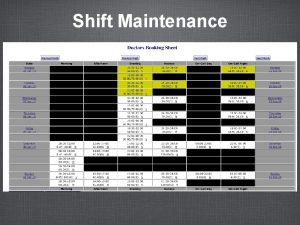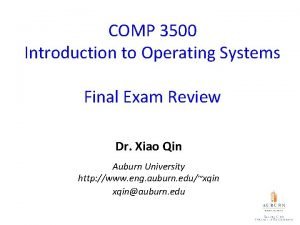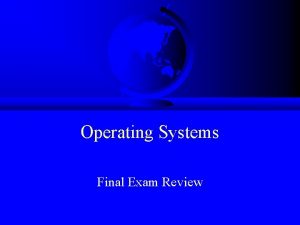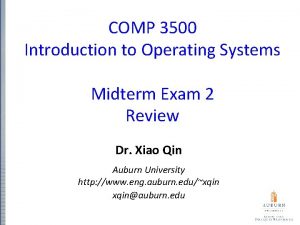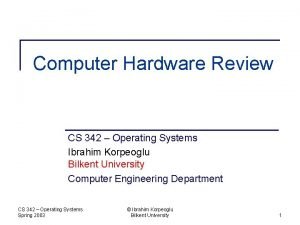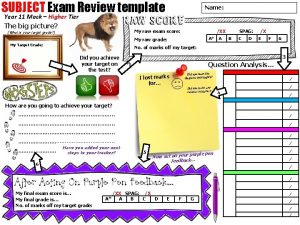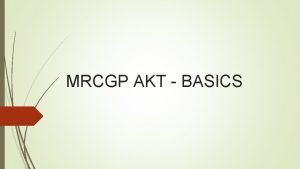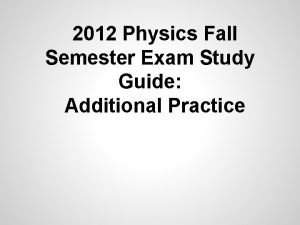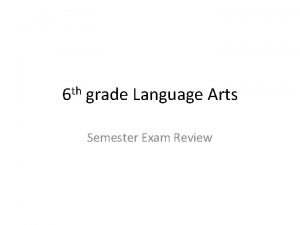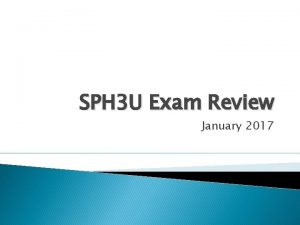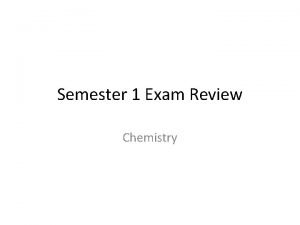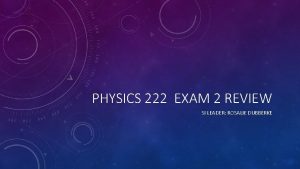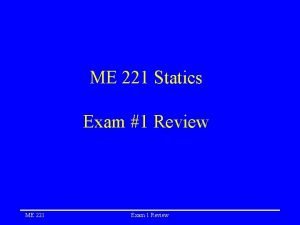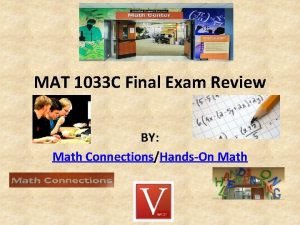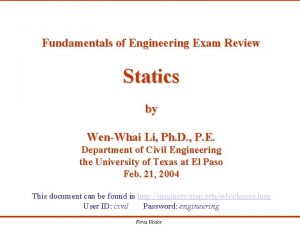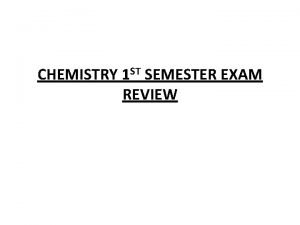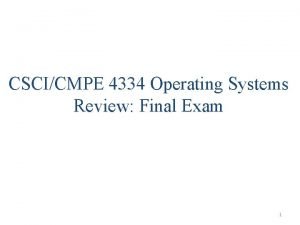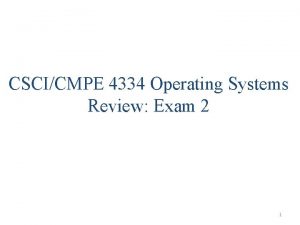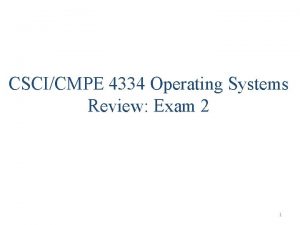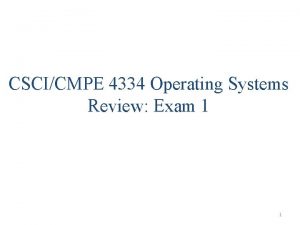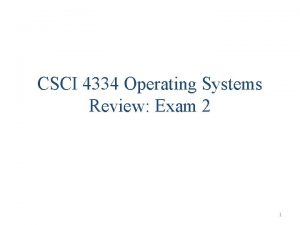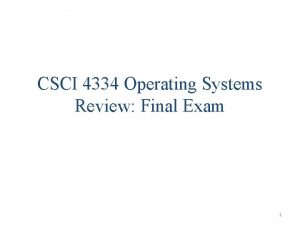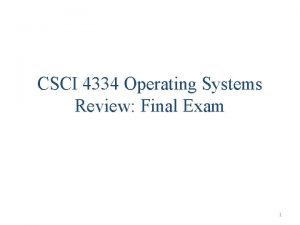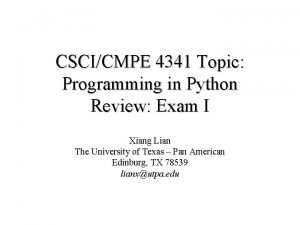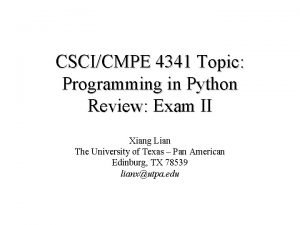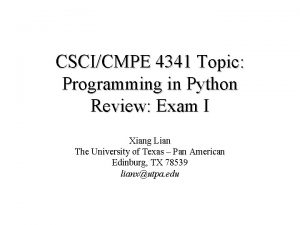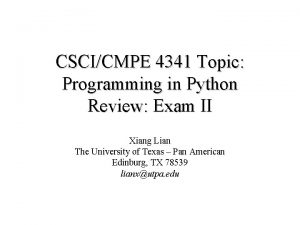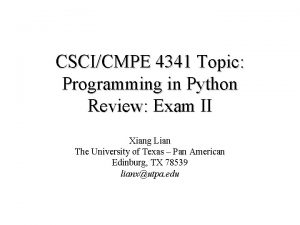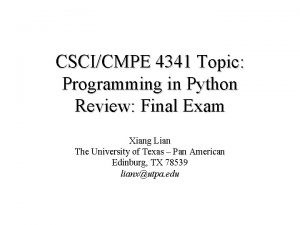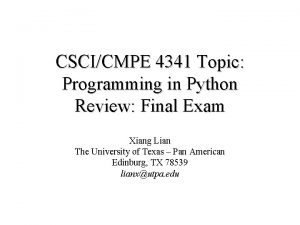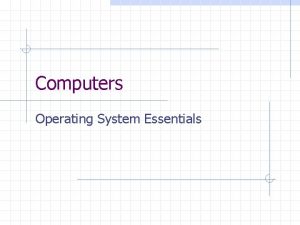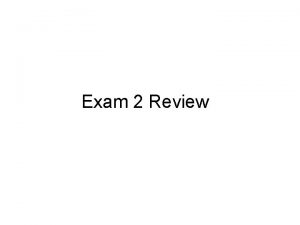CSCICMPE 4334 Operating Systems Review Exam 1 1









































- Slides: 41

CSCI/CMPE 4334 Operating Systems Review: Exam 1 1

Review • • Chapters 1 ~ 6 in your textbook Lecture slides In-class exercises (on the course website) Review slides 2

Review • 5 questions (100 points) + 1 bonus question (20 points) • Question types – Q/A 3

Time & Place & Event • 9: 25 am ~ 10: 40 am, Feb. 18, Thursday • ENGR 1. 272 • Closed-book exam 4

Chapter 1: Introduction and Overview of Operating Systems • Computer system – Hardware – Software • Application software • System software – Operating system • Operating system – resource abstraction: software & hardware abstraction – resource sharing: time & space multiplexing • Operating Systems Strategies 5

Chapter 1: Software Classification Application Programmer System Software API Command Line Interpreter Compiler Loader Libraries Database Management System Window System OS Hardware 6

Chapter 1: Purpose of an OS (What is Resource Management? ) • “An OS creates resource abstractions” • “An OS manages resource sharing” 7

Chapter 1: Operating System Functions • Resource manager – manage hardware and software resources – Resource abstraction and sharing • A nicer environment – implement a virtual machine for processes to run in • A program in execution is called a process – a nicer environment than the bare hardware 8

Chapter 1: Abstract Resources User Interface Application Abstract Resources (API) Middleware OS Resources (OS Interface) OS Hardware Resources 9

Chapter 1: Resource Management Functions • Transform physical resources to logical resources – Resource abstraction • Make the hardware resources easier to use • Multiplex one physical resource to several logical resources – Create multiple, logical copies of resources • Schedule physical and logical resources – Decide who gets to use the resources 10

Chapter 1: Resource Sharing • Two types of sharing – Time multiplexed sharing • time-sharing • schedule a serially-reusable resource among several users – Space multiplexed sharing • space-sharing • divide a multiple-use resource up among several users 11

Chapter 1: Operating Systems Strategies • Several different strategies have been used – Earliest computers were dedicated to a single program and there was no multiprogramming and no OS – Batch systems – Timesharing systems – There a few other recent strategies • • Personal computers and workstations Embedded systems Small, communicating computers Network technology 12

Chapter 2: Using the Operating System • Operating systems provide a virtual computing environment for application programmers – Functions provided by O. S. – Abstract resources by O. S. • Files • Processes and threads • Objects – Programmers can develop applications more efficiently 13

Chapter 2: Using the Operating System (cont'd) • Process – an infrastructure in which execution takes place – address space + resources • Thread – a program in execution within a process context – each thread has its own stack – Components • program counter • register set • stack space 14

Chapter 2: Using the Operating System (cont'd) • UNIX fork() creates a process – Creates a new address space – Copies text, data, & stack into new address space – Provides child with access to open files • UNIX wait() allows a parent to wait for a child to terminate • UNIX execve() allows a child to run a new program • UNIX sleep() allows a process to suspend itself for some time • Windows Create. Process() and Create. Thread() • Examples of using functions above (see lecture slides) 15

Chapter 2: Processes vs. Threads • Benefits of multithreading – Improve application responsiveness • Netscape uses multithreaded programming – Use multiprocessors efficiently – Improve program structure – Use fewer system resources – Faster to switch between threads than processes 16

Chapter 2: Algorithms, Programs, and Processes Idea Execution Engine Algorithm Source Program Status Stack Binary Program Data Files Other Resources Process 17

Chapter 2: Process Abstraction Stack Data Process Program Operating System Hardware Processor Executable Memory 18

Chapter 2: A Process with Multiple Threads Thread (Execution Engine) Status Stack Files Data Binary Program Other Resources Process 19

Chapter 2: The File Abstraction Data Stack File Process Program Operating System Hardware File Descriptor Processor Executable Memory Storage Device 20

Chapter 3: OS Organization • Basic OS Responsibilities • Basic OS Functions • Three basic implementation mechanisms – Processor modes • What are Supervisor & user modes? How to switch between them? • What are privileged instructions? – I/O instructions, and instructions to change the mode or set the halt flag – Kernels • What is trap instruction for? How to use it? – Method of invoking system service • How to perform a system call or message passing? 21

Chapter 3: Basic OS Organization File Manager Process, Thread & Resource Manager Processor(s) Memory Manager Device Manager Main Memory Devices 22

Chapter 3: Device Management • OS uses policies chosen by designer or system administrator to manage – Allocation – Isolation – Sharing • Device manager in two parts – Device independent – provides unified interface – Device dependent – device driver: handles those aspects unique to a device 23

Chapter 3: Process Management Process Mgr Deadlock Scheduler Protection Process Description Synchronization Resource Manager CPU Other H/W 24

Chapter 3: Memory Management Isolation & Sharing Process Manager Block Allocation Primary Memory Virtual Memory Storage Devices 25

Chapter 3: File System Management 26

Chapter 3: Processor Modes • Mode bit: Supervisor or User mode – Some processors may have more than one mode • Supervisor mode (privileged, protected) – Can execute all machine instructions – Can reference all memory locations • User mode – Can only execute a subset of instructions – Can only reference a subset of memory locations 27

Chapter 3: Trap Instruction … fork(); … fork() { … trap N_SYS_FORK() … } Trap Table Kernel sys_fork() { /* system function */ … return; } 28

Chapter 3: How to Make a System Call • For the system – through a trap instruction which causes an interrupt • Hardware saves PC and current status information • Hardware changes mode to system mode • Hardware loads PC from system call interrupt vector location. • Execute the system call interrupt handler • return from the handler, restores PC and other saved status information • User process continues. 29

Chapter 3: Message Passing send(…, A, …); receive(…, B, …); send/receive(…A, …); … send(…, B, …); 30

Chapter 4: Device Management • Abstract all devices (and files) to a few interfaces • Device management strategies – Direct I/O with polling – Direct I/O with interrupts – DMA I/O with interrupts – How to use the above strategies to perform I/O? • Buffering & Spooling • Access time of disk device* – FCFS, SSTF, Scan/Look, Circular Scan/Look – See examples in Exercise (2) 31

Chapter 4: Device Management Organization Application Process System Interface File Manager Device-Independent Device-Dependent Hardware Interface Command Status Data Device Controller 32

Chapter 4: Direct-Memory Access 33

Chapter 5: Implementing Processes, Threads, and Resources • • Modern process Address space Context switching State diagram 34

Chapter 5: Classic Processes • New abstraction divides aspects of classic process into two parts – Modern process: the part that defines a customized computational framework in which a program executes – Thread: the part that keeps track of code executions within this framework • Classic process = modern process with 1 thread 35

Chapter 5: The Address Space Address Binding Executable Memory Process Files Other objects 36

Chapter 5: Modern Process Composed of: • Address space • Program to define behavior of process • Data used by process • Resources needed for thread execution – Process created with a minimal set of resources – Additional resources allocated as needed 37

Chapter 5: Context Switching Old Thread Descriptor CPU New Thread Descriptor 38

Chapter 5: Simple State Diagram Request Done Running Request Schedule Start Allocate Blocked Ready 39

Chapter 5: A Generic Resource Manager Blocked Processes Policy Process request() release() Resource Pool 40

Good Luck! Q/A 41
 Maintenance shift pattern
Maintenance shift pattern Operating systems final exam
Operating systems final exam Operating systems final exam
Operating systems final exam Writ of certiorari ap gov example
Writ of certiorari ap gov example Pltw human body systems final exam review
Pltw human body systems final exam review Operating systems midterm
Operating systems midterm Computer hardware review in operating system
Computer hardware review in operating system World history spring final exam review answers
World history spring final exam review answers Exam review template
Exam review template Spanish 2 final exam review
Spanish 2 final exam review Spanish 1 review packet
Spanish 1 review packet Poe final exam
Poe final exam Gp akt sample questions
Gp akt sample questions Ied final exam review
Ied final exam review Hbs practice test
Hbs practice test World history semester exam
World history semester exam Principles of business final exam answer key
Principles of business final exam answer key Spanish 2 final exam review answer key
Spanish 2 final exam review answer key Final exam environmental science
Final exam environmental science Apes exam review
Apes exam review Ap world history jeopardy review game
Ap world history jeopardy review game Us history semester 2 review
Us history semester 2 review English semester 2 final exam
English semester 2 final exam Review for exam pronouns
Review for exam pronouns Physics fall final exam review
Physics fall final exam review Zoology semester 1 exam review answers
Zoology semester 1 exam review answers Eduqas oer
Eduqas oer Physics fall semester review answers
Physics fall semester review answers U.s. history final exam semester 2
U.s. history final exam semester 2 English 3 fall semester exam review
English 3 fall semester exam review Sph3u exam review
Sph3u exam review Verbal irony def
Verbal irony def Chemistry
Chemistry Physics 1 exam 2 review
Physics 1 exam 2 review Physics exam 2 review
Physics exam 2 review Noah carried a skateboard
Noah carried a skateboard Statics exam 2 review
Statics exam 2 review Mat 1033 final exam
Mat 1033 final exam Fe exam statics
Fe exam statics Chemistry fall semester exam review answers
Chemistry fall semester exam review answers Earth science sol review
Earth science sol review Chemistry semester exam review
Chemistry semester exam review
